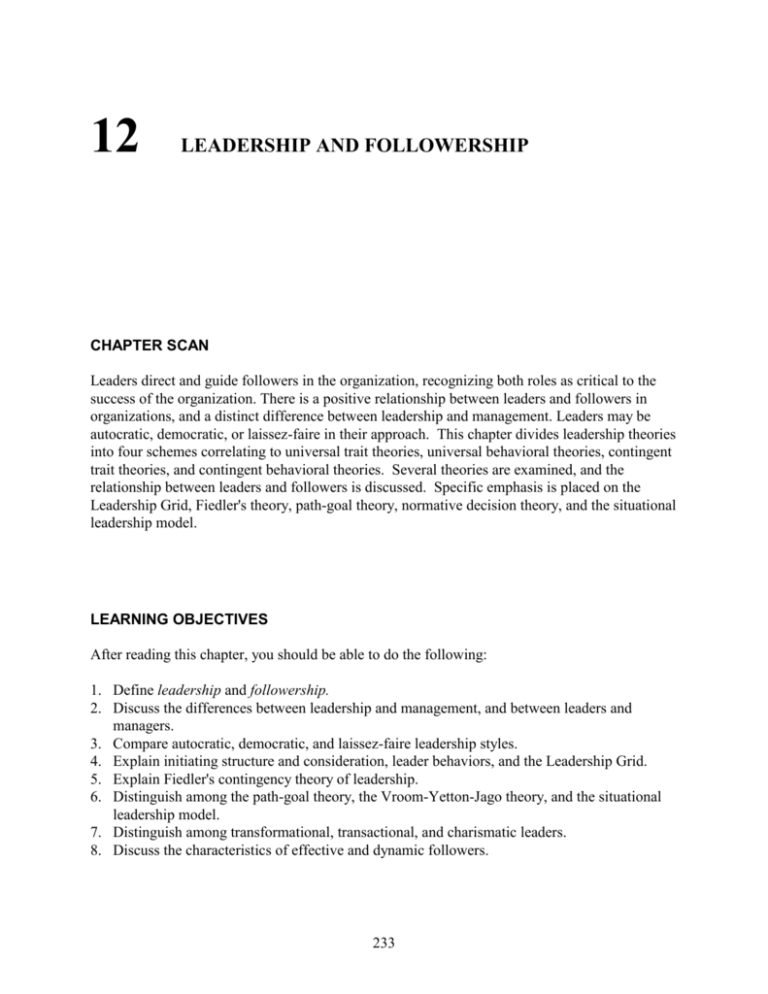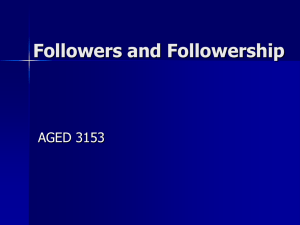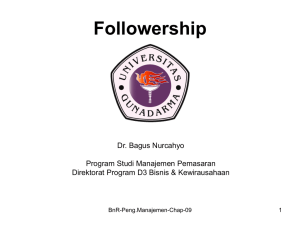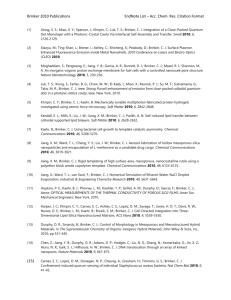12 LEADERSHIP and FOLLOWERSHIP
advertisement

12 LEADERSHIP AND FOLLOWERSHIP CHAPTER SCAN Leaders direct and guide followers in the organization, recognizing both roles as critical to the success of the organization. There is a positive relationship between leaders and followers in organizations, and a distinct difference between leadership and management. Leaders may be autocratic, democratic, or laissez-faire in their approach. This chapter divides leadership theories into four schemes correlating to universal trait theories, universal behavioral theories, contingent trait theories, and contingent behavioral theories. Several theories are examined, and the relationship between leaders and followers is discussed. Specific emphasis is placed on the Leadership Grid, Fiedler's theory, path-goal theory, normative decision theory, and the situational leadership model. LEARNING OBJECTIVES After reading this chapter, you should be able to do the following: 1. Define leadership and followership. 2. Discuss the differences between leadership and management, and between leaders and managers. 3. Compare autocratic, democratic, and laissez-faire leadership styles. 4. Explain initiating structure and consideration, leader behaviors, and the Leadership Grid. 5. Explain Fiedler's contingency theory of leadership. 6. Distinguish among the path-goal theory, the Vroom-Yetton-Jago theory, and the situational leadership model. 7. Distinguish among transformational, transactional, and charismatic leaders. 8. Discuss the characteristics of effective and dynamic followers. 233 234 Chapter 12: Leadership and Followership KEY TERMS Chapter 12 introduces the following key terms: leadership formal leadership informal leadership followership leader manager autocratic style democratic style laissez-faire style initiating structure consideration Leadership Grid organization man manager (5,5) authority-compliance manager (9,1) country club manger (1,9) team manager (9,9) impoverished manager (1,1) paternalistic “father knows best” manager (9+9) opportunistic “what’s in it for me” manager (Opp) least preferred coworker (LPC) task structure position power leader–member relations charismatic leadership dynamic follower THE CHAPTER SUMMARIZED I. LOOKING AHEAD: A Loudmouthed Activist II. LEADERSHIP AND MANAGEMENT Leaders are either formal leaders (officially sanctioned based on power and authority) or informal leaders (unofficial leadership accorded by other members of the organization). All leaders guide and direct the behavior of other people in the work environment. Leaders cannot accomplish goals without the assistance of followers. Followership is the process of being guided and directed by the leader. Chapter 12: Leadership and Followership 235 Good leaders are not necessarily good managers, nor are good managers necessarily good leaders. According to Kotter, managers control complexity and leaders produce change. Leaders work for change; managers advocate stability. Leaders and managers differ along four distinct personality dimensions: attitudes toward goals, conceptions of work, relationships with others, and sense of self. III. EARLY TRAIT THEORIES The first studies of leadership attempted to identify what physical attributes, personality characteristics, and abilities, distinguished leaders from other members of a group. Physical attributes mentioned as leadership traits included height, weight, physique, energy, health and appearance. There are biases for and against certain types of physical attributes, yet the research does not indicate that these attributes are inherently better or necessarily a leadership characteristic. Personality characteristics have been useful, and ability measurements are the closest of the three categories to being relevant. However, trait research has not been conclusive, which has led to the other approaches described in the following sections. IV. BEHAVIORAL THEORIES Behavioral theories focus on leaders’ actions and behaviors. A. Lewin Studies Kurt Lewin identified three leadership styles: autocratic, democratic, and laissez-faire. Autocratic leaders use strong, directive, controlling actions to enforce the rules, regulations, and relationships in the work environment. Students may view military leadership as autocratic, although this is a stereotype that has changed. A democratic leader takes collaborative, responsive, interactive actions with followers concerning the work and work environment. The laissez-faire leader fails to accept the responsibility of the position. Many students (and adults) confuse laissez-faire and democratic leadership styles. B. Ohio State Studies Leadership behavior is often determined by the Leader Behavior Description Questionnaire (LBDQ), which identifies the dimensions of initiating structure and consideration. A leader with an initiating structure style defines and organizes work relationships and roles, and is clear about ways of getting things done. In contrast, the consideration style leader aims at creating a nurturing, friendly, warm working relationship. 236 Chapter 12: Leadership and Followership C. Michigan Studies Similarly, studies at the University of Michigan identified the two dimensions referred to as employee oriented and production oriented. A production orientation focuses on getting the work done, with constant influence attempts by the leader. An employee orientation focuses on relationships and concern for people and their needs. D. The Leadership Grid: A Contemporary Extension Blake and Mouton developed the Leadership Grid based on the Ohio State leadership studies. The Leadership Grid is a matrix that divides types of leaders into levels of concern for either production or people. The focus, in this case, is on the leader’s attitudes. With further development, the original five dimensions of the grid have been expanded to seven. These dimensions include: organization man manager (5,5), a manager with balanced concern for people and production but commitment to neither; authoritycompliance manager (9,1), a manager who emphasizes efficient production; countryclub manager (1,9), a manager who creates a happy, comfortable work environment; team manager (9,9), a manager who builds a highly productive team of committed people; impoverished manager (1,1), a manager who exerts just enough effort to avoid being fired; paternalistic “father knows best” manager (9+9), a manager who uses both rewards and punishments; and opportunistic “what’s in it for me” manager (Opp), a manager who uses whatever style most benefits him or her. The team leader is considered ideal. V. CONTINGENCY THEORIES Contingency theories of leadership are concerned with identifying the situationally specific conditions in which leaders with particular traits are most effective. In contingency theories, traits must be considered in the context of the situation, rather than in isolation. A. Fiedler's Contingency Theory Fiedler's theory suggests that leaders are either task oriented or relationship oriented, depending on how they obtain their primary need gratification. Task-oriented leaders are primarily gratified by accomplishing tasks, whereas relationship-oriented leaders are gratified by positive, comfortable interpersonal relationships. The effectiveness of the style results from the situation in which it is enacted. To determine the fit, Fiedler developed the LPC, or least preferred coworker, questionnaire to determine the type of person with which a leader least prefers to work with. Task structure refers to the number and clarity of rules, regulations, and procedures for getting the work done. Position power refers to the leader’s legitimate authority to evaluate and reward Chapter 12: Leadership and Followership 237 performance, punish errors, and demote group members. The quality of leader–member relations is measured by the Group-Atmosphere Scale. Fiedler proposes that it is unlikely that a leader will change behavior to fit the situation. Consequently, if possible, the situation should be altered to complement the leader's style. This contingency theory emphasizes the contribution of the leader's situation. The situation has three dimensions: task structure, position power, and leader–member relations. A favorable leadership situation is one that has a structured task, strong position power, and good leader–member relations. Task-oriented leaders are more effective in either highly favorable or highly unfavorable situations. Relationship-oriented leaders are more effective in moderately favorable situations. C. The Path–Goal Theory Path–goal theory sets forth four leader behavior styles from which the leader selects the most appropriate style to help followers clarify the paths that lead them to work and personal goals. The four styles are: directive, supportive, participative, and achievement oriented. The choice of styles must be made with the specific followers and work environment in mind. This theory is based on the expectancy theory of motivation. D. Vroom-Yetton-Jago Normative Decision Theory The normative decision theory refers to a sequential set of rules that should be followed to determine the level of participation employees should be given in decision making. This theory gives credence to authoritarian approaches as well as democratic approaches, specifying that the best decision making strategy will become apparent through the use of a decision tree. This style is based on five degrees of participation from followers. E. The Situational Leadership Model The maturity level of the followers dictates the role of the leader in the situational leadership model. The positive side of this model is that it focuses on the followers as the key decision variable in determining an appropriate leadership style. As followers become mature, less task-oriented behavior and more relationship-oriented behavior is needed. VII. RECENT DEVELOPMENTS IN LEADERSHIP THEORY Four additional views of leadership are important: leader–member exchange, substitutes for leadership, transformational leadership, and charismatic leadership. A. Leader–Member Exchange In this concept of leadership, leaders form two groups of followers. In-group members are similar to the leader and are given greater responsibilities, more rewards, and more attention. Consequently, they are more satisfied, have lower turnover, and higher 238 Chapter 12: Leadership and Followership organizational commitment. Out-group members have limited responsibilities, receive less attention and fewer rewards, and are managed by formal rules and policies. B. Substitutes for Leadership The central idea of this theory is that some situations can neutralize or replace leader behavior. Satisfying tasks, high skill on the part of the employee, team cohesiveness, and formal controls are some things that can substitute for leadership. C. Transformational Leadership Transformational leaders motivate followers to achieve high levels of performance by converting vision into reality and inspiring followers to perform above and beyond the call of duty. Transformational leaders rely on their personal attributes rather than their position in motivating their followers. D. Charismatic Leadership Charismatic leadership is characterized by the use of personal abilities and talents that have a profound and extraordinary effect on followers. The charismatic leaders rely heavily on referent power, and their unique and powerful gifts generate great influence with followers. This particularly strong ability to influence followers can lead to high levels of achievement, but can also lead to great harm for the followers or others. VIII. EMERGING ISSUES IN LEADERSHIP Several issues have emerged recently from leadership research that warrant discussion. These issues include emotional intelligence, trust, virtual teams, women leaders, and servant leadership. A. Emotional Intelligence Emotional intelligence is the ability to recognize and manage emotion in oneself and in others. It includes several competencies, such as self-awareness, empathy, adaptability, and self-confidence. B. Trust Trust is the willingness to make oneself vulnerable to the actions of others, an essential element in leadership. Trustworthiness is one of the competencies in emotional intelligence. Chapter 12: Leadership and Followership C. 239 Leading Virtual Teams Virtual teams have members in different organizations, or different parts of the same organization, in diverse geographic locations. As a result, they may not have shared understandings of problems, norms, work distribution, roles, or responsibilities. Creativity is essential in leading virtual teams because the usual leader–member interactions do not exist. D. Women Leaders The question is, do women and men lead differently? Research suggests that women tend to use a more people-oriented leadership style that is inclusive and empowering, and tend to excel in positions that demand strong interpersonal skills. E. Servant Leadership Servant leadership is a view of leadership that asserts that leaders lead by serving others, that work exists for the person as much as the person exists for work, and that servant leaders are stewards who consider leadership a trust. IX. FOLLOWERSHIP This is a relatively new approach and topic, so the research accompanying the topic is scant. Followers have been viewed historically as either passive or autonomous. New concepts of empowerment and self-managed work teams have altered views of the follower role and have increased the role's importance in leadership thought and research. A. Types of Followers Followers are classified as either active or passive, and as either independent, critical thinkers or dependent, uncritical thinkers. Effective followers practice self-management and self-responsibility, and are committed to the organization and a purpose or person outside themselves. They are not self-centered, but are courageous, honest, and credible. B. X. The Dynamic Follower A dynamic follower is a follower who is a responsible steward of his or her job, is effective in managing the relationship with the boss, and practices self-management. Challenge 12.2 helps students determine whether they are dynamic followers. CULTURAL DIFFERENCES IN LEADERSHIP Globalization will increase the information available on differences in leadership styles. Limited research has indicated that there are great differences in styles among various cultures. 240 Chapter 12: Leadership and Followership XI. GUIDELINES FOR LEADERSHIP Although there is no one definitive style that is preferable in all situations, there are guidelines that are useful in most leadership approaches. First, leaders and organizations should appreciate the unique talents of each leader. Second, leaders should be chosen who challenge the organizational culture, when necessary, without destroying it. Third, participative, considerate leader behaviors appear to enhance the health and well-being of followers. Fourth, different situations require different leadership behaviors. Finally, good leaders are likely to be good followers. XII. LOOKING BACK: The Loudmouthed Leader Comes Through Chapter 12: Leadership and Followership 241 CHAPTER SUMMARY Leadership is the process of guiding and directing the behavior of followers in organizations. Followership is the process of being guided and directed by a leader. Leaders and followers are companions in these processes. A leader creates meaningful change in organizations, whereas a manager controls complexity. Charismatic leaders have a profound impact on their followers. Autocratic leaders create high pressure for followers, whereas democratic leaders create healthier environments for followers. The five styles in the Leadership Grid are organization man manager, authority-compliance manager, country club manager, team manager, and impoverished manager. According to Fiedler’s contingency theory, task-oriented leaders are most effective in highly favorable or highly unfavorable leadership situations, and relationship-oriented leaders are most effective in moderately favorable leadership situations. The path–goal theory, Vroom-Yetton-Jago theory, and situational leadership model say that a leader should adjust his or her behavior to the situation and should appreciate diversity among followers. There are many developments in leadership. Emerging issues include emotional intelligence, trust, virtual teams, women leaders, and servant leadership. Effective, dynamic followers are competent and active in their work, assertive, independent thinkers, sensitive to their bosses' needs and demands, and responsible self-managers. Caring leadership and dynamic followership go together. REVIEW QUESTIONS: SUGGESTED ANSWERS 1. Define leadership and followership. Distinguish between formal leadership and informal leadership. Leaders guide and direct the behaviors of followers in organizations. On the other hand, followers accept the guidance and direction of the leader. Formal leadership is sanctioned by power and authority. Informal leadership is accorded to an individual by other members of the organization. 2. Discuss transformational and charismatic leadership. Would you expect these styles of leadership to exist in all cultures? Differ across cultures? Transformational leaders set directions for the organization, align people with directions through empowerment, and motivate organizational followers to action. Charisma is a form of interpersonal attraction, and is an attribute found in some leaders. This trait allows leaders to be persuasive based on trust and acceptance. Charismatic leaders tend to be self-confident. Transformational and charismatic leaders may exist in all cultures; however, the types of behaviors exhibited by these leaders may differ across cultures. 242 Chapter 12: Leadership and Followership 3. Describe the differences between autocratic and democratic work environments. How do they differ from a laissez-faire workplace? Autocratic and democratic are usually easy for students to differentiate. Autocratic leaders are typically forceful personalities who are rigid in enforcing rules. In contrast, democratic leaders appreciate collaboration, and interact frequently with followers. Laissez-faire leaders abdicate responsibility and their indifference forces others into ambiguous situations. 4. Define initiating structure and consideration as leader behaviors. Initiating structure is a task-oriented approach that focuses on rules, responsibilities, and policies. Consideration is a relationship-oriented behavior that focuses on understanding one’s employees. 5. Describe the middle-of-the-road manager, authority-compliance manager, country club manager, team manager, and impoverished manager. The middle-of-the-road manager balances getting work done and maintaining morale. The authority-compliance manager emphasizes production. The country club manager focuses on the needs of people. The team manager emphasizes work accomplishment through committed people. The impoverished manager uses a laissez-faire style of management. 6. How does the LPC scale measure leadership style? What are the three dimensions of the leader’s situation? The LPC scale measures leadership style by asking leaders to describe the person with whom they would least prefer to work. The three situational dimensions are task structure, position power, and leader–member relations. 7. Describe the alternative decision strategies used by a leader in the Vroom-Yetton-Jago normative decision theory. In the AI form, the manager makes the decision alone; in the AII form, the manager seeks information from employees or peers and then makes the decision; in the CI form, the manager explains the problem to appropriate peers or employees, one-on-one, and then makes the decision; in the CII form, the manager explains the problem to employees or peers as a group and then makes the decision; in the G form, the manager explains the problem to employees or peers as a group and the group makes the decision. Chapter 12: Leadership and Followership 243 8. Compare House’s path–goal theory of leadership with the situational leadership model. Both are contingency theories of leadership that examine specific leader behaviors that are most effective in specific situations. Both propose four similar leadership styles (Path–Goal: directive, supportive, participative, and achievement oriented; Situational: telling, selling, participating, and delegating). While path–goal theory examines characteristics of both the followers and the work environment as situational characteristics, the situational leadership model only examines the maturity level of followers as a situational characteristic. 9. Describe alienated followers, sheep, yes people, survivors, and effective followers. Alienated followers think independently, but are passive; sheep do not think independently and are passive; yes people do not think independently and are active in their behavior; survivors are low-risk followers and the least disruptive; and effective followers practice self-management, are committed to the organization, are not self-centered, invest in their competence, and are courageous, honest, and credible. DISCUSSION AND COMMUNICATION QUESTIONS: SUGGESTED ANSWERS 1. Do you (or would you want to) work in an autocratic, democratic, or laissez-faire work environment? What might be the advantages of each work environment? The disadvantages? The logical answer for students to offer is a preference for a democratic environment. However, there are advantages to the autocratic and laissez-faire environments. Self-directed individuals might find it challenging to be left alone in a laissez-faire environment, if they could ultimately be responsible and receive credit for their ideas. Individuals preferring a high degree of direction might prefer the autocratic environment, or someone wanting to learn a great deal quickly might value an autocratic environment for a short time. 2. Is your supervisor or professor someone who is high in concern for production? High in concern for people? What is his or her Leadership Grid style? It is interesting to have students pool their responses regarding your leadership grid style and have them count, and put the #s in the grid on the board. You might want to do this on a day you are feeling very secure. 3. What decision strategies does your supervisor use to make decisions? Are they consistent or inconsistent with the Vroom-Yetton-Jago model? Students without work experience may wish to use the leader of an organization with which they are affiliated. It is probably worth mentioning to students that extrapolating from one incident is a dangerous approach, and very often inaccurate. The appropriate style depends on situational factors such as time quality, commitment, and information available. 244 Chapter 12: Leadership and Followership 4. Discuss the similarities and differences between effective leadership and dynamic followership. Are you dynamic? Both exhibit characteristics of responsibility and self-management. Students might want to contrast the difference between when they have been dynamic followers, and in situations they have not been dynamic followers. 5. Describe the relationship you have with your supervisor or professor. What is the best part of the relationship? The worst part? What could you do to make the relationship better? Many students have difficulty staying a dynamic follower because people generally find it easier to allow the leader to become autocratic than for them to remain dynamic followers. 6. Who is the leader you admire the most? Write a description of this person including his or her characteristics and attributes that you admire. Note any aspects of this leader or his or her behavior that you find less than wholly admirable. This question could serve as a good introduction to the material in the chapter. As each theory of leadership is discussed, references could be made back to characteristics and attributes that students identified in their most admired leaders. 7. Refresh yourself on the distinction between leaders (also called transformational leaders) and managers (also called transactional leaders) in the text. Then read about four contemporary business leaders. Prepare a brief summary of each and classify them as leaders or managers. In this assignment, it is important that students tie specific examples of the behaviors and characteristics of the four leaders they read about to specific characteristics of leaders and managers given in the text. 8. Interview a supervisor or manager about the best follower the supervisor or manager has worked with. Ask questions about the characteristics and behaviors that made this person such a good follower. Note in particular how this follower responds to change. Be prepared to present your interview results in class. Compare and contrast the responses of different supervisors and managers regarding their best followers. Students could be challenged to consider whether or not they, personally, exhibit these characteristics in work and/or school settings. Chapter 12: Leadership and Followership 245 ETHICS QUESTIONS: SUGGESTED ANSWERS 1. Is it ethical for leaders to tell followers unilaterally what to do without asking their opinions or getting any input from them? Some would counter that it is ethical to take responsibility for actions, rather than to delegate the responsibility to others. The example that comes to mind is the situation where the Japanese CEO resigned because of embarrassment related to a product. In some high profile examples in the U.S., we have instances where no one takes responsibility for actions. 2. Is it acceptable for a leader to take credit for the work of followers for whom he or she has responsibility? Most students will relate that they know this happens frequently. However, it is a form of deceit. 3. If a leader is using a delegating leadership style and big problems develop in the team's work, is the leader still responsible for what happens? Yes, legally and by lines of responsibility. Legal cases often cite both the immediate supervisor and the stakeholders of the company in wrongful acts. Delegating does not relieve one of responsibility. 4. If a follower disagrees with the supervisor's directions, is the follower obligated to follow those directions anyway? Or is the follower obligated to be disobedient while adhering to a moral principle? The first question and the second question are very different. The first asks only if there is a disagreement, and does not mention a moral or ethical issue. Authority mandates that we fulfill our responsibilities. However, we do not have to follow acts that we view as immoral. 5. What should you do if your supervisor acts in an unethical or illegal manner? Talk with the supervisor? Immediately report the action to the company's ethics committee? Problem reporting is increasing in organizations because many organizational members have been frustrated with ethics violations. If an employee is fearful of reprisal, there should be a reporting procedure to bring the issue to light outside the immediate working department. Most of the time, if the employee is convinced that the supervisor is acting with knowledge of the wrongful act, it is better for the individual to bypass the supervisor. Also, it is a different situation if there are other individuals involved in the matter. 246 Chapter 12: Leadership and Followership CHALLENGES 12.1 HOW DOES YOUR SUPERVISOR LEAD? This would be a good challenge to have students complete before discussing task and people orientations to leadership so that they have a personal experience to relate to the text material. 12.2 ARE YOU AN EFFECTIVE FOLLOWER? Students who do not fall into the category of an effective follower may want to consider the implications of this for the type of job they might choose. They may also want to consider specific steps they could take to become a more effective follower. Chapter 12: Leadership and Followership 247 EXPERIENTIAL EXERCISES 12.1 NATIONAL CULTURE AND LEADERSHIP This instrument measures Hofstede’s four traditional dimensions of national culture – uncertainty avoidance, individualism, power distance, and masculinity. It also measures a fifth dimension, paternalism. “The paternalism scale includes items that assess the appropriateness of managers taking a personal interest in workers’ lives, providing for workers’ personal needs, and generally taking care of workers.”1 The following shows which items should go with which scales: 1-5 6-11 12-17 18-24 25-29 Uncertainty avoidance Individualism Power Distance Paternalism Masculinity This instrument has no scoring mechanism. There are two ways to evaluate the results: 1. Have the students determine their total scores for each of the five sections (higher score is indicative of strength on that dimension towards the value the dimension’s title indicates) and see which of the dimensions scores higher. They can see, relative to themselves, how the dimensions vary in strength. 2. Take mean scores from the whole class either: a) for each separate item b) for each of the five sections Then write these means on the board and discuss the relevance of the variability of the scores. 1 Adapted from Peter Dorfman, Advances in International Comparative Management, vol. 3, pg. 127-150. Copyright 1988 by JAI Press Inc. Used with permission. D. Marcic and S. M. Puffer, “Dimensions of National Culture and Effective Leadership Patterns: Hofstede Revisited,” Management International (Minneapolis/St. Paul, West Publishing, 1994): 10-15. 248 Chapter 12: Leadership and Followership 12.2 LEADERSHIP AND INFLUENCE Instructor's Notes: Students do not have to have been in an authority position to answer the leadership questionnaire. Be sure to mention to students that lack of experience might, however, influence their scores. One of the more interesting discussions surrounding this survey is to ask students that score high on the people-oriented to change their style. ALTERNATIVE EXPERIENTIAL EXERCISE LEADERSHIP TALKS Instructor's Notes: One important way to instill the difficulties of leadership is to provide students with the opportunity to fulfill a "locker room talk" classroom activity. Up to three students sign up for one of the topics provided, with the understanding that they will deliver a one to two minute talk on the topic. For each topic, three students could make presentations. Students are asked to select a topic, and sign up for a particular time, within a two-week time frame. Students are free to select the organizational scenario to which their speech will pertain. Talks should last 1 to 2 minutes each. It is helpful to have a timekeeper signal the end of each 2-minute speaking period. Before the "clock begins", each student is asked to provide a brief description of the scenario selected. The audience plays the role called for by the day's topic. After each set of 3 presentations (for a class of 36), there is a brief discussion about the leadership style and presentation. To ensure useful feedback, 3 rules might be helpful: (1) Do not allow the day's speakers to comment during the critique period. This prevents defensive reactions and excuse making. (2) Make sure all speakers receive some feedback. Although one speaker may overshadow others, all should receive critical commentary. (3) Make sure speakers learn at least one strength and one weakness of their performance. Students with limited experience, unfortunately, sometimes see the exercise as primarily a speech-making effort. They should be encouraged to see it in its broader context. Chapter 12: Leadership and Followership 249 LEADERSHIP TALKS Richard G. Linowes, "Filling a Gap in Management Education: Giving Leadership Talks in the Classroom", Journal of Management Education, Vol. 16, (1), February 1992, 6-24. TOPICS FOR THE LEADERSHIP TALKS 1. 2. 3. 4. 5. 6. 7. 8. 9. 10. 11. Taking charge of an established group The speaker is a manager now newly assigned to a group that has worked together under other managers for some time. Announcing a new project The speaker is announcing a new undertaking to members of his or her department and is calling on all to rally behind the effort. Calling for better customer service The speaker is motivating all employees to be attentive and responsive to the customer. Calling for excellence and high-quality work The speaker is motivating all employees to perform their jobs with a commitment to meeting the highest possible standards. Announcing the need for cost reductions The speaker is requesting that everyone look for ways to cut expenditures and immediately begin slashing spending. Commending for a job well done The speaker is motivating all employees to perform their jobs with a commitment to meeting the highest possible standards. Reprimanding unacceptable behavior The speaker is calling to task certain individuals who have failed to perform up to required levels. Calming a frightened group of people The speaker is endeavoring to restore peace and confidence to those who now panic in the face of distressing business developments. Addressing a challenging opposition The speaker is presenting some heartfelt belief to a critical, even hostile, audience. Mediating opposing parties The speaker is calling for reconciliation between two groups bitterly opposed on some key issue. Taking responsibility for error The speaker is the figurehead spokesman for an institution that has produced some unfortunate result affecting the audience. 250 Chapter 12: Leadership and Followership Lessons From Each Leadership Topic Suggested issues to be raised when discussing each leadership talk topic: 1. Taking Charge of an Established Group This talk is the icebreaker, in which students first appreciate the pain and value of class feedback. The audience looks for openness and confidence in their new leader. They respond well to signs of a team orientation and a healthy respect for their accumulated knowledge and experience. Authoritarian introductions may work, but not without associated risks and down-the-road costs. New leaders must be aware that in some settings a few individuals may feel resentment that they were not given the leadership position; such situations require special sensitivity. 2. Announcing a New Project This talk is a leader's declaration of group responsibility for a new endeavor. The audience looks for an upbeat, enthusiastic introduction to the project, presented with the leader's assurances that the undertaking is both important and feasible. Acknowledging the group's past achievements, the leader may expect the project to be challenging, demanding the best work from each and every individual on the team. 3. Calling for Better Customer Service This talk is the first of a series of admonitions aimed at steering the group in a direction of possible major strategic importance. Describing the current negative situation - stemming typically from the increased competition, lax performance standards, or more demanding customers - the leader calls for change. Public finger pointing for past mistakes is usually not effective, but illustrative behaviors help make the point. Expressing understanding and empathy for the strains of customer contact helps build rapport with the audience. Looking forward, the leader may set some targets and call for renewed individual and group accountability. He or she may solicit new ideas for improving service and express confidence that the team can bring about the desired turnaround. 4. Calling for Excellence and High-Quality Work This talk is another effort to steer the group in a direction of possible strategic import, focusing attention on the quality of people's work. At some point in time, most groups require such improvements, whether the deficiencies reflect the actions of a few individuals or the group as a whole. The discussion might focus on the importance of quality work, the need for renewed commitment to high standards, and a reiteration of personal and group accountability. The audience welcomes a leader's openness to new ideas and expressed confidence that the group can institute all needed changes. Chapter 12: Leadership and Followership 251 5. Announcing the Need for Cost Reductions Although this talk also steers the group in a direction of possible strategic importance, it expresses a theme that is important to every budget-conscious organization. Some historical perspective on creeping costs or eroding profits is usually helpful, as well as some indication of specific budget items that have now become excessive. Key discussion points include the importance of the matter at hand, the value of setting targets, and the need for personal and/or group accountability. Many students addressing this topic present an ultimatum, raising the possibility of job dismissals or layoffs. People should understand the positive and negative cultural implications of such approaches. Illustrations drawn from real work experience of participants are welcome here. 6. Commending for a Job Well Done This talk represents a joyous occasion for speaking to a group of people, perhaps insufficiently practiced in many organizations. The audience appreciates the leader who will take time out to celebrate their accomplishments. Such talks provide public acknowledgment of group efforts, and they recognize and thank those who have played key roles at work. Missed or fumbled opportunities for uttering praise can breed resentment and a we-versus-they mentality. Many students are too cavalier in rushing to offer financial rewards for good work; they should understand that most organizations provide very limited opportunities for sizable bonuses and that generous bonus schemes often carry undesirable consequences (stirring up possible resentments: for example, is it equitable? Will it be available next year now that people expect it?). Finally, the instructor may use this topic to comment on the value of nonverbal communication: During the discussion period, challenge someone to come forward to commend the group for a job well done without using any words. 7. Reprimanding Unacceptable Behavior This talk is the flip side of a commendation, for here the objective is to correct the group's wrongdoing, although poor quality work or excessive costs may trigger such a speech, even more insightful are those occasions when the leader calls for an end to unethical or unsportsmanlike behavior. It is the behavior that is unacceptable, not the people - as long as they correct their ways. The effective speaker is very clear and very firm, explaining exactly what is unacceptable and why it is so. He or she then sets a clear standard and describes the consequences of any continued wrongdoing. The audience responds well to the leader who speaks with true conviction and appears unwavering. The leader may end on a positive note, emphasizing the importance of moving forward to tackle the work that they must accomplish together. 8. Calming a Frightened Group of People This talk begins the focus on the more emotional side of organizational life, where the leader plays a key role in stemming people's fears while holding the group together. The audience looks to the leader's assurances of personal resolve, and if possible, personal control over the situation at hand. They appreciate the leader's understanding and sense of concern for them as people, and they welcome a personal pledge of continued openness and support. Interesting scenarios selected for this topic include sudden financial loss, corporate takeovers, terrorist threats, and even earthquakes. 252 Chapter 12: Leadership and Followership 9. Addressing a Challenging Opposition This talk, the second focusing on emotional issues, provides the forum for exploring the fundamental role of commitment in the demonstration of true leadership. Here, the leader presents some heartfelt message to a hostile audience, demonstrating a show of courage and personal resolve. The experience highlights differences between popularity and effectiveness ("sometimes you've gotta do what you gotta do") and between casual speech and speaking with conviction. Interesting scenarios selected for this topic include labor hostility, environmental opposition, and anti-military demonstrations. 10. Mediating Opposing Parties This talk is a demonstration of the key role of a leader in forging a reunification of opposing groups within an organization. Reminding the group of their shared superordinate goals and common vision, the leader shakes them from their provincial concerns, instills in them a spirit of compromise, and renews their common pursuit of shared commitments. The audience responds favorably to the leader who expresses understanding of each opposing viewpoint while acknowledging each viewpoint's legitimacy. Effective speakers also sometimes pinpoint a deadline for moving forward, demanding finality in the resolution of the dispute. 11. Taking Responsibility for Error This talk presents the leader with the difficult task of admitting error to external groups for organizational misdeeds, oversights, or alleged violations of the public trust. The leader here is the symbol of institutional identity and continuity. As spokesperson to the outside world, the leader must work to restore trust in the organization, its values, and its intended contributions to society. The audience responds favorably to announcements that are sincere, that demonstrate the organization's willingness to take responsibility for the past, and that state specific action plans for responsible behavior in the future. 12. Petitioning for Special Allowances This talk illustrates the leader's role in representing the organization to external bodies that exercise some degree of control over its activities. As spokesperson for the institution, the leader stands for its mission and values and now seeks to win the hearts and minds of those in control of some critical levers affecting the organization's destiny, be they financial, legal, regulatory, or resource related. Chapter 12: Leadership and Followership 253 EXTRA EXPERIENTIAL EXERCISES The following alternative exercises to supplement the material in the textbook can be obtained from: Marcic, Dorothy, Seltzer, Joseph, & Vaill, Peter. Organizational Behavior: Experiences and Cases, 6th Ed. South Western College Publishing Company, 2001. The President’s Decision: A Role-Play. p. 161-164. Time: 35-50 minutes or more. Purpose: To explore the effects of different types of leadership styles on group members. Path-Goal Leadership: The Pat Howard Role Play. p. 145-151. Time: 45 minutes per round (second round optional), plus 15 minutes for discussion. Purpose: To determine what leadership styles are most effective with different subordinates. CASE QUESTIONS: SUGGESTED ANSWERS NORMAN BRINKER AND BRINKER INTERNATIONAL 1. In what ways is Norman Brinker a manager? In what ways is he a leader? A manager controls complexity; a leader creates meaningful organizational changes. In controlling complexity, a manager focuses on (a) planning and budgeting, (b) organizing and staffing, and (c) controlling and problem solving. In creating meaningful organizational change, a leader (a) sets a direction for the organization, (b) aligns people with that direction through communication, and (c) motivates people to action through empowerment and basic need gratification. The information in the case provides more evidence of Norman Brinker as a leader than Norman Brinker as a manager. However, the fact that Brinker has headed several successful ventures in the highly competitive restaurant industry indicates that he has given attention to planning and budgeting, organizing and staffing, and controlling and problem solving. Norman Brinker as a leader is demonstrated through the following evidence: Brinker believes that “winners attract winners.” Brinker says, “The people I’ve been able to attract over the years are terrific individuals. They want to do better. And the success is contagious.” Brinker is “driven by integrity, teamwork, passion, and an unwavering commitment to making sure each and every guest has an enjoyable dining experience.” All of these examples relate to the leadership activities of setting direction and aligning people. 254 Chapter 12: Leadership and Followership 2. Describe the kind of followership that Norman Brinker has attempted to develop at Brinker International. The most plausible answer is that Norman Brinker sought to develop Brinker International into a business composed of effective followers. According to the text, effective followers share four characteristics: They practice self-management and self-responsibility. They are committed to the organization as well as to a principle, purpose, or person other than themselves. They invest in their own competence and professionalism and focus their energy to have maximum impact. They are credible, courageous, and honest. In terms of the first characteristic, Brinker’s statement that “winners attract winners” suggests that he wants to have take-charge followers who are ambitious and want to succeed. Additionally, Brinker observed, “The people I’ve been able to attract over the years are terrific individuals. They want to do better. And the success is contagious.” This also indicates that Brinker has sought responsible, self-starters. Support for the second and third characteristics is found in the following statements by or about Norman Brinker: (a) He is “driven by integrity, teamwork, passion, and an unwavering commitment to making sure each and every guest has an enjoyable dining experience.” (b) Through example and personal involvement, Norman Brinker has promoted an ethical organizational culture where people respect one another and work collaboratively in seeking to provide excellent meals and excellent service. The fourth characteristic is demonstrated by Norman Brinker being “widely regarded as one of the most influential chain builders in food service history,” by his willingness to accept the challenges associated with starting new restaurant chains (and being successful at it), and by being integrity-driven. 3. What skills would you personally need to develop to become a leader like Norman Brinker? What could you do to develop or refine those skills? Discussion of this question should build upon the suggested solution to question (1). The suggested response to this question revolves around setting direction and aligning people. The students should consider what they would need to do in order to be effective at establishing direction for an organization and getting the organization’s members to enthusiastically support and work toward realizing the established direction. Students could consider their skills at setting a direction and aligning people in the context of a club or student organization to which they belong. In this situational context, the students should also discuss what specific activities they could undertake in order to develop or refine their direction setting and/or people alignment skills. Chapter 12: Leadership and Followership 255 4. What do you think is the most important leadership lesson in this case? Explain your answer. Two different, though related, approaches could be used for promoting discussion of this question. One approach builds on the suggested solution for question (1). Specific examples of Brinker’s leadership activities are cited, and these may be used to foster a discussion of lessons about leadership. The other approach uses the suggested solution for question (2) as a point of departure for the discussion. Here the focus is on what Brinker does to ensure that he has effective followers. In using either approach, the students should explore in some detail the reasons why they consider a particular leadership lesson to be the most important one. They should also consider the reasons for relegating specific leadership lessons to a less important status. Role Plays Additional roleplays relevant to the material in this chapter are located in Appendix A of this instructor's manual.









